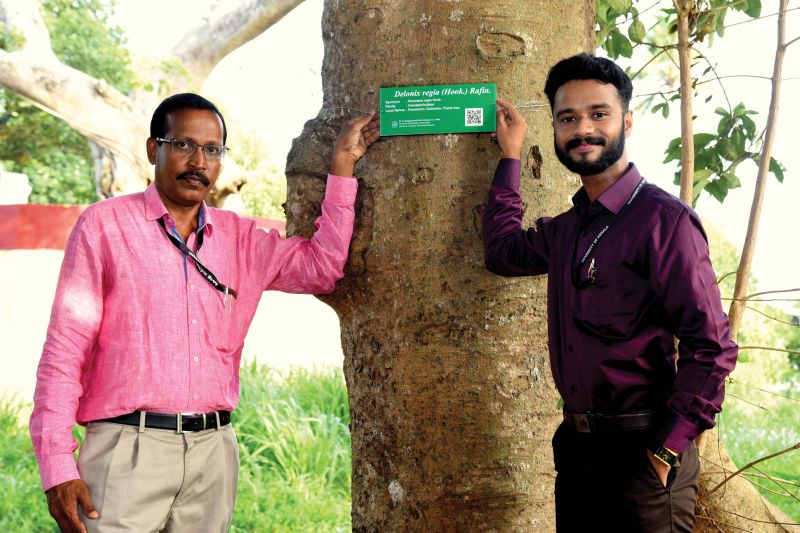Digital hub of trees

Last year, Kanakakunu Palace in the capital city became the first public place in India to have a digital garden. Though it was just an idea that Akhilesh S.V came up with in order to complete the dissertation for his post-graduate studies, it grabbed people’s attention and he was approached by the Centre for Biodiversity Conservation for documentation and digitisation of tree species of Kerala Raj Bhavan. Akhilesh’s planning and methodical approach towards the task helped him complete the project along with his guide Dr A. Gangaprasad, making Kerala Raj Bhavan India’s first Raj Bhavan with a digital garden.
 Akhilesh with his mentor Gangaprasad
Akhilesh with his mentor Gangaprasad
Akhilesh S.V, a research scholar who worked to make Kerala Raj Bhavan as India’s first Raj Bhavan with a digital garden, says it will increase people’s interest in trees.
An overwhelmed Akhilesh says, “It was a proud moment for us when the document titled ‘Trees of Kerala Raj Bhavan’ – India’s First Raj Bhavan with Digital Garden was handed over to Governor Justice (Retd) P. Sathasivam. He appreciated our work. As a person who is extremely inclined towards plant taxonomy, it was never a hectic task for me. My guide, Gangaprasad sir helped me execute the project in every step with utmost sincerity.”
Akhilesh is of the opinion that though the process of digitising the garden is initially a complex task, once all the species are identified, 183 in the case of Kerala Raj Bhavan, gathering every possible information regarding the trees without leaving out even the minute details just happens seamlessly.
The garden plants were not taken into account as they are changed methodically. “Once we get to know the variety of species present in a place, the things fall in place. A database of every information regarding each and every tree is created and uploaded on the website. We have created a website called Trees of Kerala Raj Bhavan and the URL of the website has been used to create the QR code which is pinned to the trees. Those visiting the place, if feels like getting the information regarding the tree, can scan the QR code and they will be redirected to the website from where they can get the information, which they would otherwise get by searching at least seven to eight blogs.”
The research scholar stresses that their ultimate aim is to make people aware of the rich biodiversity of our area and also the rare and unique trees found here. He adds that the medicinal properties of every tree has been highlighted, which is a lesser known fact among the public.
Elaborating on the practical aspect of digitising the garden, Akhilesh says, “It is a human tendency not to read long descriptions placed beside a tree or a monument. However, a QR code shall intrigue people to know what would be on the website. People will, therefore, scan the code and read at least some information about the tree. I feel that this will in a long run increase our sensitivity towards trees.”
Akhilesh further adds that most of the floristic documentation is done in forest and such projects will help us identify the biodiversity in urban settlements as well.

